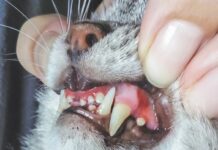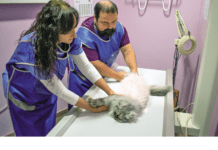Don’t Hold Back at the Vet
When veterinarians ask, “How are things at home?” they probably dont want to hear about your mortgage, your migraines or Aunt Millie in the guestroom. They should be asking about “lifestyle” issues that might be affecting the health of your cat. Problem is, too few vets do, according to a report in the Journal of the American Veterinary Medical Association (JAVMA Vol. 233, No. 10) about client-veterinarian communications.
The study compared verbal interactions during well-pet visits – the once-a-year checkups (or twice-yearly visits for older cats) as opposed to vet appointments when a medical problem prompted a visit. Typically, as it turns out, well-pet visits include more verbal interaction with the pets, according to the report: Wellness appointments included “twice as much verbal interaction with the pet as did problem appointments, and the emotional atmosphere of wellness appointments was generally relaxed. There were more social talk, laughter, statements of reassurance and compliments directed toward the client and the pet.”
In contrast, during problem visits, 90 percent of the talk focused on what the report called “biomedical topics.” And that is a problem, the JAVMA report concluded, because “veterinarians may neglect lifestyle and social concerns that could impact patient management and outcomes” when focusing on biomedical issues.
Our advice is this: Even if the vet doesnt ask, tell about those lifestyle issues. Youre the one who knows your cat best.
How to Remove a Heartworm
The late Dr. Jim Richards, who used to write a Q&A column for this newsletter and who was one of the countrys top authorities on cat health, consistently warned that cats can get heartworm almost as easily as dogs can.
Now we know why Dr. Richards was worried, after reading this article in another issue of JAVMA (Vol. 233, No. 9): “Use of a nitinol gooseneck snare catheter for removal of adult Dirofilaria immitis in two cats.
Dirofilaria immitis is the heartworm (the ultimate result of a bite from an infected mosquito), and an adult worm can be almost snake-like in size. Unfortunately, heartworms dont always go away with medication.
The article describes two cats who did survive their “heartworm” ordeal despite having already used up several of their nine lives when being admitted to the veterinary hospital at Texas A&M University: “Both had loud right-sided heart murmurs, precordial thrills and jugular distension,” the surgeons reported. Those “thrills” were the result of sizeable heartworms lounging in their heart valves.
So one more bit of advice (and then well stop): Ask your vet if heartworm is a problem for cats in your neck of the woods. Here in upstate New York, where Frannie the ShortTakes feline resides, it reportedly is.
Why Cats Have Seizures
Even more disturbing than the thought of heartworms in a pet is the sight of a cat in the throes of an epileptic seizure. Veterinary researchers classify seizures by their cause.
They talk about reactive seizures (where the cats nervous system and muscles are reacting to toxins or some chemical imbalance that affects its metabolism) and symptomatic (where seizures can be traced to disease in the heart, brain, to a traumatic injury or to cancer). The most puzzling kind of seizures is called idiopathic – meaning that no cause can be found.
A long-term study in a major veterinary college hospital (reported in JAVMA Vol. 233, No. 10) found a surprisingly high number of idiopathic seizures in cats referred to that hospital – nearly 25 percent. And they were among the youngest cats seen at the hospital for seizures.
Heres the good news: Once they were diagnosed and started on routine medical treatments, most of the idiopathic-seizure cats lived long and relatively uneventful lives.



